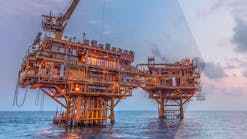Frank Hartley • Houston
Transmitting in real time
Expro achieved another successful application of its cableless telemetry system (CaTS) in a UK North Sea offshore platform well. The well, W160 on the Mungo platform (UKCS block 22/20) operated by BP Exploration Ltd., had problems with a cabled permanent gauge system and BP was interested in evaluating technologies to restore the flow of real-time reservoir pressure and temperature data without having to workover the well.
Prior attempts to retrofit this system in the offshore platform environment have challenged the technology, thus promoting an extensive program of research and development, which resulted in this breakthrough. New signal processing hardware makes it possible to relay the CaTS signal to the surface using the failed permanent gauge and cable as a signal path.
The new development allows information to be transmitted in real time to and from downhole instruments without a wireline. Its two-way transmission capability enables remote control of downhole instrumentation and opens the path to redesign of downhole completions.
The system was retrofitted into the well on slickline in November as part of a routine well intervention and transmits data from the reservoir to surface. The system’s topside data receiver is interfaced to the platform SCADA (supervisory control and data acquisition) system, enabling bottomhole pressure and temperature data to be received in real time by engineers onshore.
Knowledge Reservoir implements Reservoir KB
Knowledge Reservoir LLC has developed its deepwater Gulf of Mexico knowledge base, Reservoir KB. It provides coverage of all the deepwater reservoirs currently either in production or sanctioned for development. It provides unique, continually updated reservoir performance metrics, analogs, lessons learned, and regional knowledge.
Reservoir KB provides a hosted portal to a group of 18 operators in the region. The updates are provided annually. Reservoir KB has grown, together with deepwater activity in general, from an initial coverage of 26 fields, to currently 182 fields and 379 reservoirs.
Reservoir KB features a map-based interface that lets you select a field then drill down to reservoir and well information.
This release includes a map-based interface that lets users select a field then drill down to reservoir and well information, or navigate into the system using a search engine.
“Originating with the benefit of DeepStar funding, Reservoir KB was developed in response to operators’ needs for a knowledge base of deepwater data to evaluate projects, assess risks, and measure them against other opportunities in their portfolios,” says Dr. Ivor R. Ellul, president of Knowledge Reservoir.
Well services completed off Côte d’Ivoire
BJ Tubular Services has completed well services offshore Cote d’Ivoire for Foxtrot International. Company personnel performed hydraulic hammer conductor-driving, casing and tubing running, and completion assembly services.
To complete development wells FA3 and FA4, the BJ teams worked from KCA’sSearex 10 tender-assist barge to drive three 26-in. (66-cm) conductors, and run casing and tubing. In addition, company technicians provided casing and tubing running services from GlobalSantaFe’s jackup rig AD6 on an exploration well.
The company completed the program with support from its base in Abidjan, Cote d’Ivoire. A full complement of conductor-driving, casing, and tubing running equipment was used, including the flush-mounted spider and Chromemaster completion tools.
Aker Kvaerner launches IOR tool
Aker Kvaerner has developed the PodEx, a new technology to maximize oil and gas recovery from mature subsea fields. PodEx integrates new functions and instrumentation directly into the existing subsea control system. It requires little installation time.
The module uses spare subsea electrical circuitry or co-existent power supplies to convey increased well and reservoir data to topside data acquisition systems for analysis. It is scalable and offers an adaptable, transparent communication layer. It also can be combined with controls system from all system manufacturers.
“This new solution is in sharp contrast to previous, more complex alternatives, which have required either changing or redesigning the original control system. The module instead uses existing infrastructure for power and communication,” says Erik Taule, acting senior vice president of Aftermarket, Aker Kvaerner Subsea.
Well confirms Nemo field extension
Lundin Petroleum drilled the appraisal well 7/4-2 in block 7/7 and 7/4 production license PL 148, on the Norwegian Continental Shelf (NCS), confirming an extension of the Nemo field, discovered in 1992.
The well was drilled to a vertical depth of 3,416 m (11,207 ft) below the sea surface using the jackup rigMærsk Giant. The well encountered hydrocarbons in the Ula formation. The well was not tested. Data was obtained through an extensive acquisition program, including reservoir fluid sampling.
The company was carrying gross contingent resources for the Nemo field of 20.6 MMbbl of oil prior to drilling the appraisal well. Initial revised gross resources estimates for Nemo now are 20-30 MMbbl. The well results will be evaluated by the partnership to support a likely development decision.
Lundin Norway AS is the operator of PL148 with a 50% working interest. Partners are Talisman Energy Norge AS (30%) and Norwegian Energy Co. AS (20%).
“We are pleased with the successful results of the Nemo appraisal well, which we hope will now lead to a commercial development of this field,” says Ashley Heppenstall, president and CEO of Lundin Petroleum. “We will be drilling further appraisal wells this year on the Luno and South East Tor discoveries, which we hope will lead to further reserve additions in our Norwegian portfolio.”






